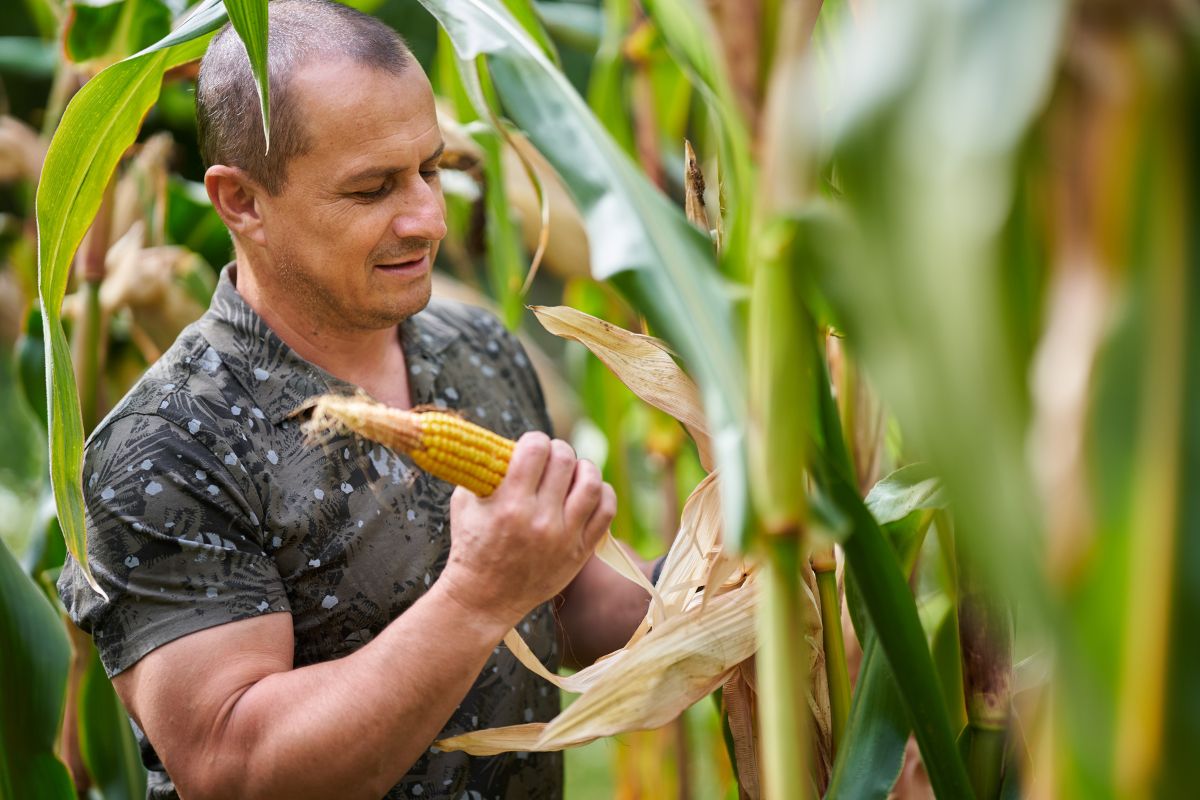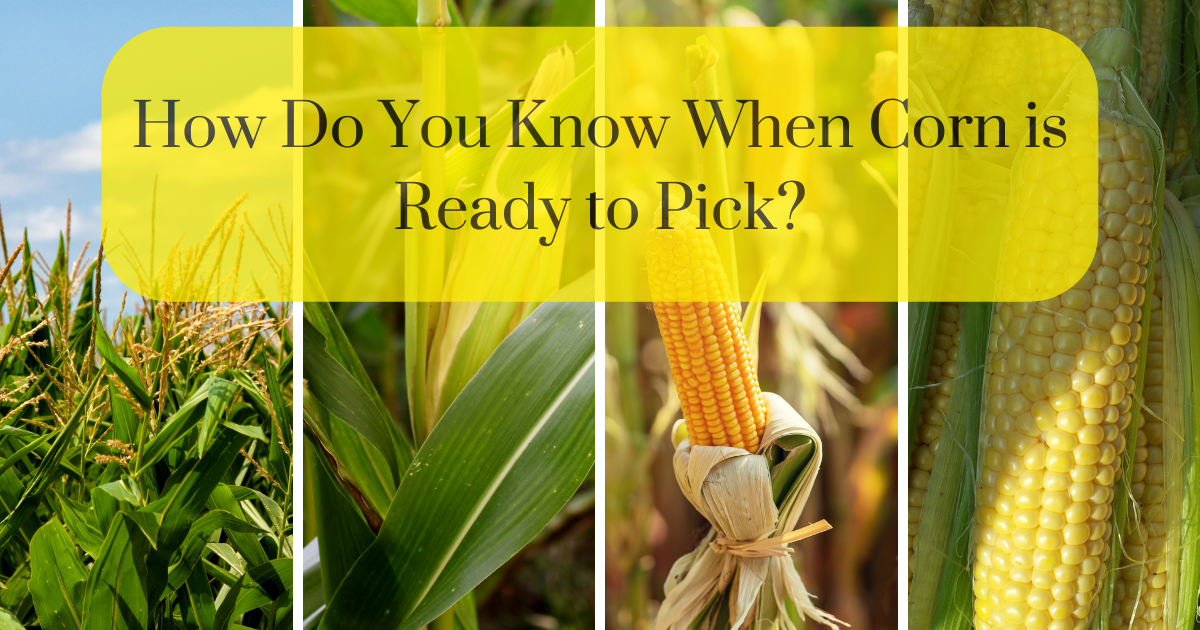Harvesting Corn
The appearance and texture of tomato or strawberry can tell you if they are ripe or not. But how do you know when corn is ready to pick?
Because freshly picked corn is a delight and tastes far better than corn from the grocery store, gardeners are ready to invest their time and garden space in cultivating it. Continue reading for information about corn harvesting that will assist you in determining when to pick corn.

How Do You Know When Corn is Ready to Pick?
One day you’ll be staring up at stalks of corn that are now taller than you and wondering if it’s time to cut those ears off for tonight’s dinner. Here are the hints you need to know to make the critical choice. What do the silks at the top of the corn cob look like first?
Are they withered, dried, and brown? Or are they still shiny and light yellow? Tassels at the top of the stalk will fertilize the corn silks and wither as the ears develop. Three weeks after the silks form, this occurs. At about the same time, the silks turn brown and shrink, and the maize kernels ripen.
Check the kernels themselves to ensure you aren’t picking an ear too early. Make a tiny vertical cut through the husk of one of the ears. Keep the cut small so that you don’t unintentionally make it easier for pests to creep in, even though you do want to get the kernels.
Pick a kernel that is a few kernels down from the top of the ear. You’re looking for corn kernels that are compact and full. To pierce a kernel, use your fingernail. They are not ripe if the liquid emerges clear and watery.
The corn is ready to pluck if you can see through the drink, but it still appears milky. Additionally, if the liquid is opaque, you’ve waited too long (you cannot see through it). You’ll get extremely adept at determining the freshness of your corn simply by looking at the kernels after a season or two of experimenting and guesswork.
Experienced gardeners have long practiced boiling corn as soon as possible after harvesting since you only have around three days after they mature before the kernels’ sugars change to starch. However, some of the more recent supersweet varietals have lessened that concern.
How to Harvest Corn
When is corn ready to harvest? You can legally harvest dent corn when it reaches the “milk stage,” when the kernels begin to bleed a milky sap.
After germination, corn harvest time is usually 70 to 80 days later. But why would you do that when sweet maize is in existence for that reason?
Alternatively, try letting your corn on the plant for 100 to 120 days or until it has completely dried out in the field. To the touch, the stalks and silks should feel brown and crisp. You should break cobs off the stalks and hang them by the husks to finish drying in a warm, dry environment.
Use a hand-held thresher to shuck the corn after a week or two. If a corncob is sufficiently dry, the kernels should easily separate from the cob without clogging the thresher. If they stick, continue drying the grains for a further week.
Until you’re ready to make cornmeal, keep the kernels you’ve separated from the cobs in an airtight container. Making coarse cornmeal or finely ground corn flour in a powerful blender like a BlendTec or Vitamix is simple. You can start cooking after putting a cup or two of kernels in the blender and pulsing them to the right consistency.

Harvest Sweet Corn
Harvesting sweetcorn is an activity you can enjoy. Sweetcorn that you cultivate at home is a delicious treat. You should know when to harvest corn properly. You must harvest it properly. It is important to know signs that sweet corn is ready.
When the tassels (also known as the silks) at the top of your sweetcorn cobs become a cocoa brown color, it’s time to harvest them. Peel back the outer leaves covering the cobs of sweet corn to access the cob’s kernels.
If one yields a milky sap when you press it with your fingernail, the cobs are mature and ready for harvest. The cobs are not yet ready if the kernels create a watery liquid. Put the leaves back on the plant, keep it well-watered, give it a weekly dose of liquid tomato fertilizer, and check on it again in a week or two.
After preparation, twist the bottom of the cob and pull it downward to free it from the plant. You should pluck sweetcorn cobs only when you are ready to cook them. They quickly lose their freshness. When the cob is ready for harvesting, try to do so just as the water on the cooker is boiling.
This will ensure that they are as fresh as possible. If you have a block of sweetcorn plants serving as a windbreak and not already, leave the plant alone after harvesting. If not, pull the plants up, use some garden loppers to cut them up into little pieces, and then put the entire plant matter into the compost pile.
Fresh Corn Storing Information
Once you pluck corn, it quickly loses its sugars. For this reason, attempt to consume it right away. If you can’t use it straight away, you can keep it undamaged for a few days in the refrigerator.
Try to blanch your corn cobs as soon as you harvest them if you are growing corn to preserve and enjoy all year long. Place the shucked ears in a pot of boiling water, cook them for four minutes, and then remove them immediately. Please put it in freezing water to stop the cooking, and then use a knife to remove the kernels.
You have two options at this point: freezing or canning. Wait until the corn kernels are firm to the touch and the husks are dry and papery if you plan to dry your corn. Check an ear to see if the grains come out readily by picking them up. You store this as kernels in glass jars or other tightly sealed containers.
Making dry cans is a fantastic way to keep food fresh. Keep in mind that dry maize is vulnerable to insect damage when storing.
How to Identify the Type of Corn You are Growing
There are several varieties of corn, and they are into groups according to how you intend to use them. What kind would you like to grow? Here is a summary of the different types of corn:
Sweet Corn
Z. mays var. saccharata or Z. mays var. rugosa, sometimes known as sweet corn, is the kind you plant for fresh corn on the cob. Picked just after the silk goes brown, the kernels start to leak a milky liquid when they mature. It is essential to have information on how to know when sweet corn is ready.
Dent Corn
The maize that you can use to produce homemade corn tortillas is dent corn (Zea mays var. indentata). You can use this to feed livestock. It is also called field corn.
Flint Corn
You can use the variety of hues of flint corn (Zea mays var. indurata), often known as Indian corn, to make cornmeal or to feed animals.
Flour Corn
To create corn flour, Z. mays var. amylacea is typically in use.
Popcorn
Popcorn (Z. mays var. everta): The preferred corn at your neighborhood cinema!
FAQs on Corn
How Many Times Can You Harvest Corn in a Year?
If you plant your corn all at once, you may typically only harvest it once during the growing season in the US. Nevertheless, depending on your climate, planting succession crops—starting fresh seeds every week or a few weeks—can result in many harvests in a single year.
Does Corn Grow Back After You Pick It?
No. Just a few corn ears will grow from a corn stem. Picking it won’t stimulate the growth of any more ears.

Final Words
The chance to eat fruits, corn, and vegetables when they are at their freshest and greatest is one of the biggest reasons to have your garden. Some veggies, which are practically hard to buy at their best because they only reach their top for a very short period, are particularly rewarding for growers. Read our article and find out What Temperature Is Too Cold For Plants?
One good example is sweet corn (Zea mays subsp. mays). The only real way to savor sweet corn at its best is to plant it in your backyard and know the right time when maize is picked.
